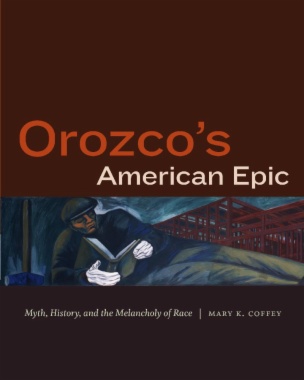Between 1932 and 1934, José Clemente Orozco painted the twenty-four-panel mural cycle entitled The Epic of American Civilization in Dartmouth College's Baker-Berry Library. An artifact of Orozco's migration from Mexico to the United States, the Epic represents a turning point in his career, standing as the only fresco in which he explores both US-American and Mexican narratives of national history, progress, and identity. While his title invokes the heroic epic form, the mural indicts history as complicit in colonial violence. It questions the claims of Manifest Destiny in the United States and the Mexican desire to mend the wounds of conquest in pursuit of a postcolonial national project. In Orozco's American Epic Mary K. Coffey places Orozco in the context of his contemporaries, such as Diego Rivera and David Alfaro Siqueiros, and demonstrates the Epic's power as a melancholic critique of official indigenism, industrial progress, and Marxist messianism. In the process, Coffey finds within Orozco's work a call for justice that resonates with contemporary debates about race, immigration, borders, and nationality.
- Cover
- Contents
- List of Illustrations����������������������������
- Preface��������������
- Acknowledgments����������������������
- Introduction�������������������
- Epic, National Narration, and Counternarrative
- Mexico, U.S. Antiempire, and the Borders of Identity
- Melancholy, Race, and Performance
- Idea, Intention, and the Melancholy Art
- Summary of Mural, Chapters, and Argument
- Chapter 1. Orozco’s Melancholy Dialectics
- The Rivera–Siqueiros Debate over the Mural Form
- Rivera’s Material Dialectics: History as Discourse
- Siqueiros’s Cinematographic Mural Art: The Visual Politics of Affect
- History as Ruin: Orozco’s Poetic Image
- The Benjamin Interlude: Allegory, Melancholy, and the Dialectics of History
- Orozco as Critical Philosopher: Form and Politics
- The Epic as Dialectical Image
- Chapter 2. Colonial Melancholy and the Myth of Quetzalcoatl
- Quetzalcoatl: The Myth, the Man, the Prophecy
- The Postrevolutionary Quetzalcoatl: Messianic Politics and Indigenism
- Orozco’s Quetzalcoatl
- Rivera’s Quetzalcoatl
- Reframing Quetzalcoatl: Allegory and the Irony of Empire
- Time, History, and Prophecy: Quetzalcoatl and Weak Messianism
- Chapter 3. American Modernity and the Play of Mourning
- Part I. Cortés and the Spanish Conquest
- Rivera’s Cortés
- Orozco’s Cortés
- Part II. The Conquest, the Two Americas, and the Thanatopolitics of Race
- The Machine and the Two Americas: Orozco’s Version
- Rivera’s Vision of Industry and Pan-American Cooperation
- Death, Sacrifice, and the Melancholy of the American Dream
- Part III. Cortés, Christ, and Weak Messianism
- Rivera’s National Palace: Technology, Progress, and Messianic Redemption
- Orozco and the Phantasmagoria of Sovereignty
- Chapter 4. “Modern Industrial Man” and the Melancholy of Race in America
- The Supplement
- Neither Dartmouth Man nor Emiliano Zapata
- The Worker Who Reads
- Between Mestizaje and Minstrelsy
- Vestigial Blackface, Artistic Freedom, and the Poetics of Plasmatics
- Disidentification and the Melancholy of Race in America
- Conclusion
- “Greening the Epic”: The “Hovey Mural”
- The “Evil Grandchildren of Orozco”: Orozco MEXotica
- Notes
- Bibliography�������������������
- Index������������
- A
- B
- C
- D
- E
- F
- G
- H
- I
- J
- K
- L
- M
- N
- O
- P
- Q
- R
- S
- T
- U
- V
- W
- X
- Y
- Z

